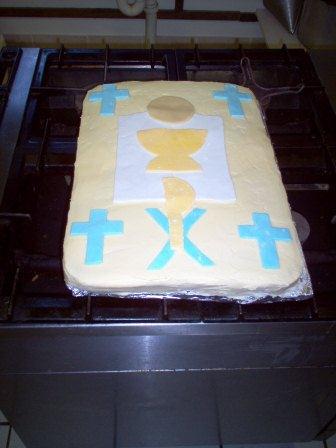Written by Sue Elvis
Six year old Charlotte couldn't wait to receive her First Holy Communion. Everything had been arranged: she’d learnt her catechism, prepared for confession, tried on her white dress and veil. Only one more thing needed to be done: bake a celebratory cake.
Six year old Charlotte couldn't wait to receive her First Holy Communion. Everything had been arranged: she’d learnt her catechism, prepared for confession, tried on her white dress and veil. Only one more thing needed to be done: bake a celebratory cake.
Now there is nothing difficult about baking an ordinary
sized cake, but what about baking a cake big enough to feed a crowd? Charlotte’s
First Holy Communion took place at a homeschooling camp. There were thousands (really only a hundred or so!) children there. And all those children loved cake.
This is how we solved the huge cake problem:
I decided I would make a very simple cake using bought
packet mixes.
I bought two large rectangular tins to bake the cakes in. (The
kind used for roasting potatoes or chicken.)
I worked out how many packet mixes were needed for each
large tin. To do this, I had to compare the capacity of one large tin to an ordinary
sized cake tin, by filling the larger tin with water using the smaller tin as a
measure.
I then decided how big a cake I wanted, using the large tin
as my basic unit.
I can’t remember the exact measurements but let’s suppose…
One large tin equals 4 small cake tins…
And I wanted a cake 4 times the size of the large tin…
Then I had to buy 16 packet cake mixes.
Is this getting confusing? I feel like I'm doing a homeschoolers' maths problem…
I made up the cake mixes, poured them into the large tins
and cooked them in the oven, two tins at a time.
I then wrapped each cooked-and-cooled cake in plastic wrap, and froze them
until the day before the First Holy Communion.
He designed some simple and appropriate decorations to go
on top of the cake: a chalice, crosses, the Host… He drew them on baking paper
and cut them out to make templates.
Andy then divided the icing into three pieces. One piece was
coloured blue and one yellow, using food dyes. The third piece remained white. The
icing was rolled out and the decorations were cut out using the paper templates.
The decorations were then wrapped in plastic wrap and refrigerated.
On the morning of the First Holy Communion, we made up a
large batch of simple butter icing: we creamed together softened butter and
icing sugar to taste. (There are lots of recipes online.)
The thawed cakes were placed on the board. They were covered
with the butter icing. The decorations were added to the top of the large cake.
Voila! The cake was ready to be eaten after the First Holy Communion Mass.
Of course, if your cake doesn’t need to feed such a large
number of people, and you want it to be very special, you could bake your cake
from scratch. Here’s our favourite celebratory cake recipe.
You could also make a Confirmation cake the same way, using
prepared icing Fruits-of-the-Holy-Spirit decorations. This is only a small cake but a larger rectangular cake could be made...
Or a baptism cake.
How about a simple wedding cake? This is the cake Imogen
made for her big sister’s wedding. Each cupcake was decorated with silver balls and
white icing flowers.
Charlotte’s First Holy Communion cake looked impressive. No
one realised it was a packet mix cake. There was plenty for everyone. It was a great
success.
One very simple but delicious cake. And one very happy First Holy Communicant.







These cakes look wonderful, Sue! I love being creative with colour like this - I wonder if we could make a sugar-free version??
ReplyDeleteGod bless:-)
Vicky,
DeleteYou could use any cake recipe but I imagine a sugar-free one would be much more expensive to make for a crowd. I am not sure about sugar-free roll out icing for the decorations. Is there such a thing? If there is, tell me!